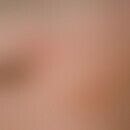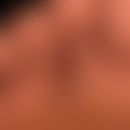Synonym(s)
Seabather's eruption; Sponge diver disease
DefinitionThis section has been translated automatically.
Exogenous acute toxic contact eczema caused by contact with cnidarian larvae toxins. It can lead to allergic reactions (cross-allergens!) up to anaphylactic shock. S.a.u. Dermatitis medusica.
Occurrence/EpidemiologyThis section has been translated automatically.
Coastal regions, e.g. on the coasts of Florida and the Caribbean (Linuche unguiculata); mid-Atlantic and northeastern coasts of the USA (Edwardsiella lineata)
You might also be interested in
EtiopathogenesisThis section has been translated automatically.
Contact with triggering cnidarian toxins occurs, for example, when bathing, snorkelling or sponge diving. Usually the larvae get caught in the bathing clothes and release their toxin on chemical or physical stimuli, usually by drying them off or showering them with fresh water. The triggers vary according to the geographical region: larvae of the cnidarians Edwardsiella lineata (sea anemone) and Linuche unguiculata (foxglove jellyfish).
ManifestationThis section has been translated automatically.
Seasonal accumulation in the bathing season of March-August with a peak in May after the spawning of the cnidarians.
ClinicThis section has been translated automatically.
Typically, the skin changes appear a few hours after bathing in infected water in places that were covered by the swimwear. Very itchy papules and/or urticae appear. Later on, superinfection with subsequent ulcerations may occur.
Complication(s)(associated diseasesThis section has been translated automatically.
Anaphylactic reactions.
TherapyThis section has been translated automatically.
- In many cases the injuries are harmless and heal within a short time. Residual hyperpigmentation is possible. In case of shock symptoms: treatment of anaphylactic shock, see below. shock, anaphylactic shock.
- Further measures:
- Fixation of the nettle capsules with acetic acid solution or isopropanol (if not available shaving foam).
- Rinsing with sea water (do not rinse with fresh water as fresh water causes the nematode cysts to burst osmotically, releasing further toxins).
- Remove the tentacle remains with tweezers (not with the bare hand!), if necessary under superficial local anaesthesia (e.g. EMLA cream, ice spray).
- Cooling (cooling compresses or ice or ice spray).
- If necessary, topical glucocorticoids such as 0.1% betamethasone lotio (e.g. Betagalen) or 0.25% prednicarbate cream (e.g. Dermatop cream).
- Antihistamines such as desloratadine (e.g. Aerius 1-2 Tbl./day) for severe itching and urticarial changes.
- Necrosis formation: see below Wound treatment.
- Superinfection: if necessary antibiotic treatment with broad-spectrum antibiotics, e.g. macrolides or gyrase inhibitors.
General therapyThis section has been translated automatically.
Immediate measures:
- Leave the water immediately due to danger of an anaphylactic reaction!
- Avoid that other persons come into contact with cnidarian remains unprotected when assistance is given! Wear gloves.
- Inactivation and, if possible, rinsing preferably with vinegar water, otherwise with alcohol in any form or olive oil. If no aids are available, remove the cnidarian mucus with dry sand (only completely dried mucus).
Remember! Only completely dried mucus should be scraped off mechanically!
Outgoing links (4)
Anaphylactic shock; Contact dermatitis toxic; Dermatitis medusica; Wound treatment;Disclaimer
Please ask your physician for a reliable diagnosis. This website is only meant as a reference.




